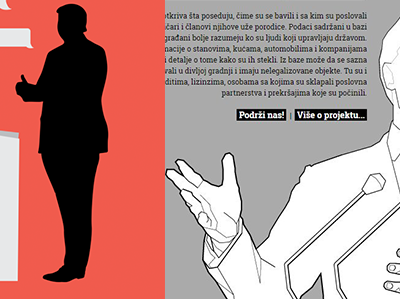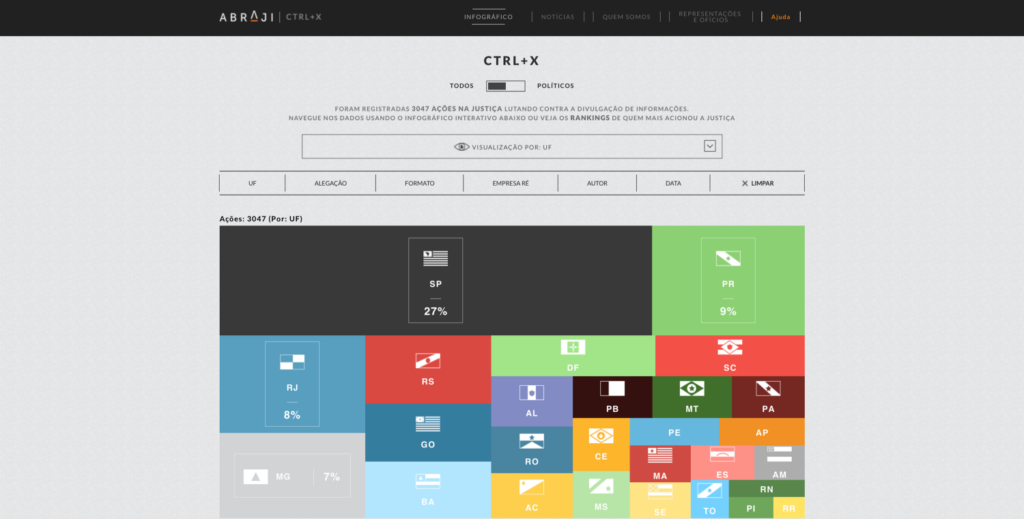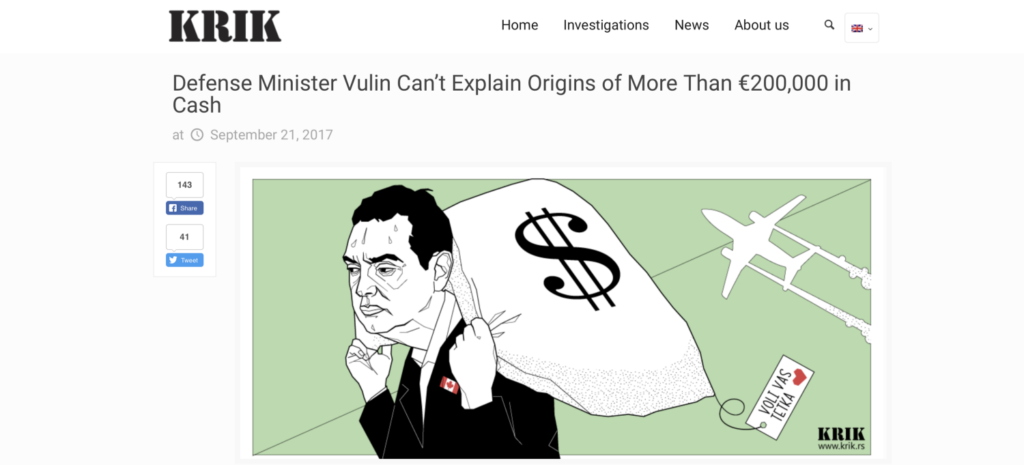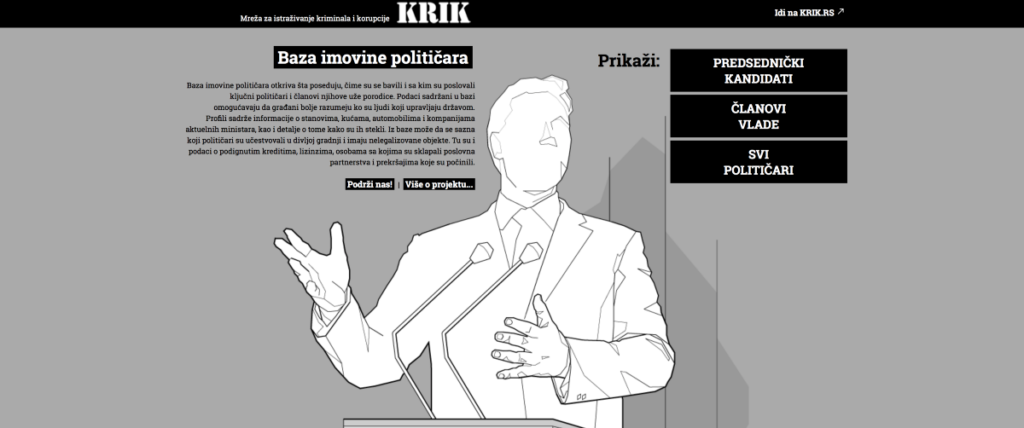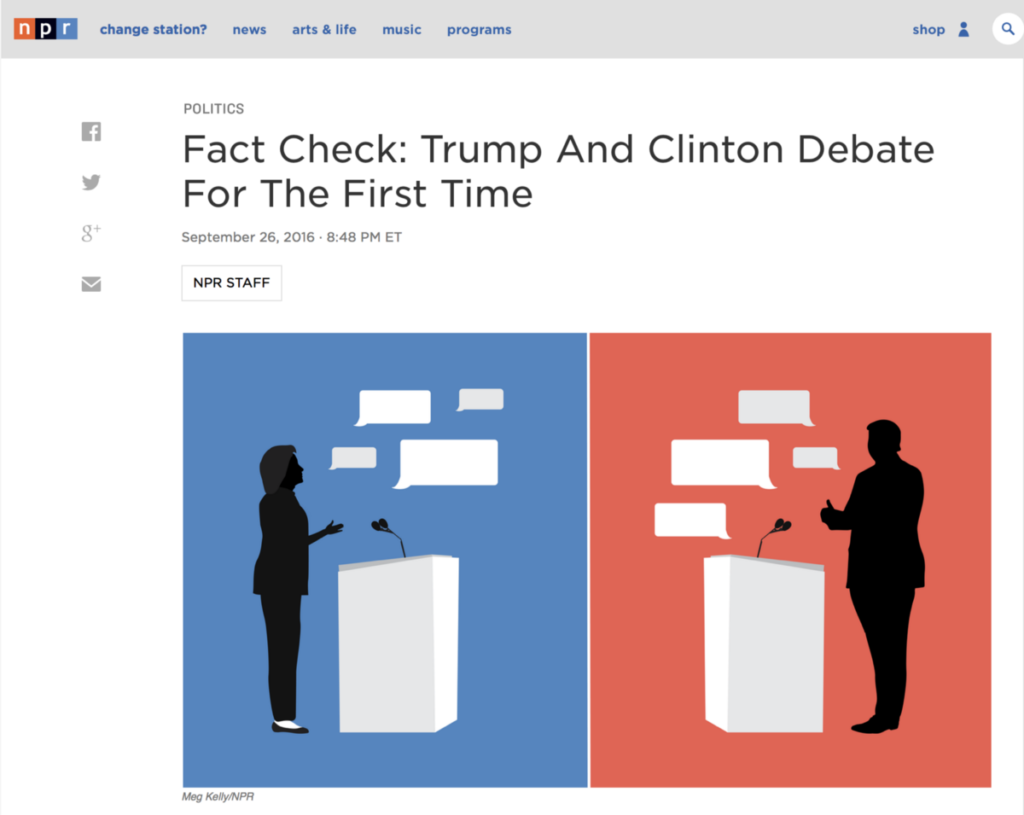This article was originally published on the Data Journalism Awards Medium Publication managed by the Global Editors Network. You can find the original version right here.
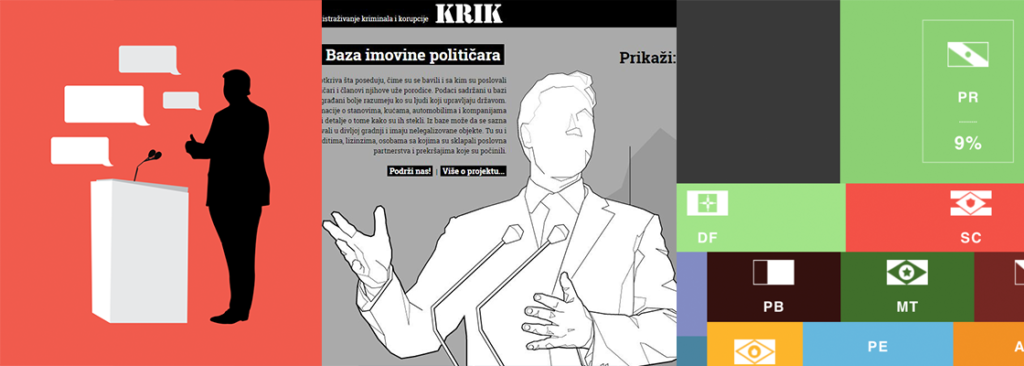
From left to right: screenshots of Fact Check: Trump And Clinton Debate For The First Time (NPR, USA), Database of Assets of Serbian Politicians (KRIK, Serbia), and Ctrl+X (ABRAJI, Brazil)
It is referred to as one of the main goals of modern journalism, and yet, in many parts of the world, holding the powerful accountable causes a great amount of threats and challenges.
How do you go about investigating corruption and finding the data that your government or powerful individuals want to keep hidden? What issues do most data journalists face when working on such investigations and how do they tackle them?
As season 7 of the Data Journalism Awards competition starts this fall, we’ve set up a group discussion on Slack last week and gathered Amita Kelly of NPR (USA), Jelena Vasić of KRIK (Serbia) and Tiago Mali of ABRAJI (Brazil) to discuss the challenges of holding the powerful accountable using data. The three of them gave us great insights on the state of data journalism across Eastern Europe and the Americas.
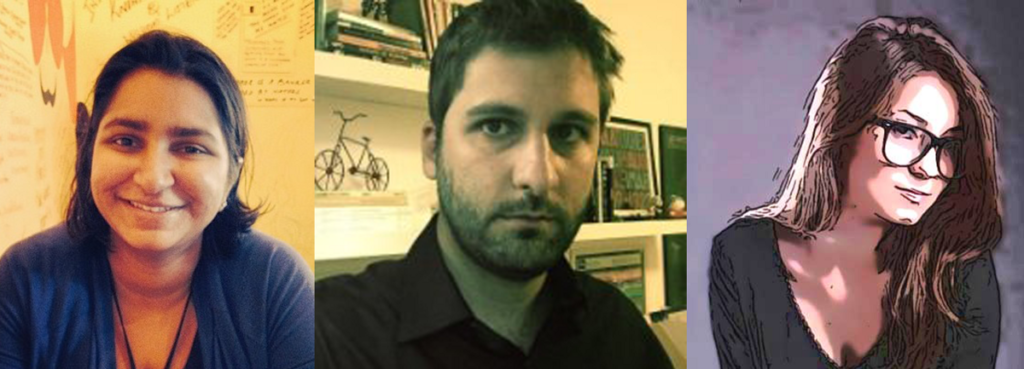
From left to right: Amita Kelly of NPR (USA), Tiago Mali of ABRAJI (Brazil) and Jelena Vasić of KRIK (Serbia)
In Brazil, the political and judiciary systems seem to go hand-in-hand against freedom of speech
“There is a perception, amongst the politicians and the judiciary system, that they don’t have to be accountable,” said Tiago Mali, project coordinator at The Brazilian Association of Investigative Journalism (ABRAJI) in Brazil.
“The checks and balances are too weak and the judges are often close to the politicians. So many times the first instance judges favour censorship against the media to preserve the politicians. They help each other against freedom of speech.”
In September 2017, the mayor of Betim, a city in Minas Gerais, sued a website that published an investigation against him, Mali explained. The journalist who worked on the story also received threatening calls.
The team at ABRAJI realised that part of the problem was that the judiciary system was not held accountable. They started to expose judges, lawsuits and decisions that aimed at censoring the media.
“It’s our way to increase society’s pressure on them and to shed a light on their misbehaviour,” Mali said.
“We haven’t been directly threatened here in ABRAJI, but we report on cases of many journalists that are being constantly threatened.”
A Brazilian project denounces politicians trying to remove information from the public eye
ABRAJI won a Data Journalism Awards prize in June 2017 for their project Ctrl+X which scraped thousands of lawsuits and catalogued close to 2500 filed by Brazilian politicians who were trying to hide information from the public eye.
“We started because we realised there were too many cases of politicians pulling their weight to silence journalists in courts. We knew of former presidents, governors, and mayors using the judiciary system to prevent the publication of news about them they were not too comfortable with— a practice that we assumed had died with the dictatorship in the 80’s,” Tiago Mali said.
“We didn’t know then how many cases they were amounting to, so we did what every good journalist should do in such a situation: we started the count ourselves.”
In the beginning, in 2014, ABRAJI asked media lawyers and media organisations to provide them with details on the lawsuits filed against them. This work had some impact on the 2014 elections, but not everyone was willing or had time to cooperate.
So the team wanted to go further. In 2015 and 2016, ABRAJI developed scraping tools to parse the many court websites in Brazil for this sort of lawsuits. “As we improved our system, we started to count the cases not in dozens, but in thousands,” Tiago Mali said. “We cannot say that we were not surprised by this.”
“Since its publication, CTRL+X has not only provided insightful data on freedom of expression, but also made their data available for other media to report on the transparency issue. It was crucial that this data be of use for the 2016 election,” said Yolanda Ma, editor of Data Journalism China and jury member of the Data Journalism Awards competition.
Journalists who investigate politicians’ wrongdoings in Serbia face multiple threats
In September 2017, Serbia’s Defense Minister, Aleksandar Vulin has been at the heart of an investigation by KRIK, the Crime and Corruption Reporting Network in Serbia. He told the country’s anti-corruption agency that his wife’s aunt from Canada lent the couple more than €200,000 to buy their Belgrade apartment, but did not manage to submit convincing evidence to support his claim.
“Vulin’s political party then started publishing official statements against KRIK’s editor, and this for several days,” said Jelena Vasić, journalist at KRIK. They allegedly said that “KRIK’s editor Stevan Dojcinovic was a ‘drug addict who needs to be tested for drugs’, and accused him of being paid by foreigners to attack the minister.”
The political party also rudely attacked every public figure which stood for KRIK’s defence.
After this incident, EU institutions informed Belgrade that they will be tracking the behaviour of Serbia’s officials towards media organisations during the accession process.
But this is not an isolated incident for KRIK. Last July, the home of Dragana Peco, award-winning KRIK’s investigative reporter, was broken into, and her belongings turned over, Jelena Vasić explained alleging to foul play. “KRIK journalists have also received death threats on social media,” she said.
A Serbian database of politicians assets
KRIK won a Data Journalism Awards 2017 prize last June for creating the most comprehensive database of assets of Serbian politicians, which currently consists of property cards of all ministers of Serbian government and all Serbian presidential candidates running in the 2017 Elections.
The database was launched to help Serbian citizens to better understand who the people running their country are and promote greater transparency.
Each profile contains information about the apartments, houses, cars and companies of current ministers or presidential candidates, and details about how they came to possess them.
“What KRIK did with their database project went beyond simply opening data up for examination; they opened minds,”said Paul Radu, executive director of the Organized Crime and Corruption Reporting Project (OCCRP), also member of the Data Journalism Awards 2017 jury.
“Their work allowed people in Serbia, where open access to data is limited, to see what wealth their politicians had accumulated. The publication of the database sparked investigations by the Serbian Anti-Corruption Agency. At the same time, KRIK journalists were monitored and recorded, and the organisation subjected to smear campaigns. But they persevered in the name of public accountability and transparency.”
The Online Database of Assets of Serbian Politicians attracted a lot of attention. No other organisation in Serbian had ever gone to such depth to investigate this subject as KRIK did.
This database has contributed to higher government transparency and now, details on politicians that would otherwise be hidden are in the public domain.
Journalists in the USA also get their share of challenges
It is no secret that trying to enforce transparency from prominent figures is an uphill battle in the US, barely six month ago, the current President elusive tax returns were a hot topic. “We find that it varies a lot with who is in power and what agency we are looking at,” said Amita Kelly, digital editor for NPR.
“Some are much more transparent and have very detailed policy papers, for example, that can be picked apart. Our challenge in the 2016 election was that with the increasing use of digital and social media by campaigns and candidates, it was often difficult to parse what is truly a policy versus an opinion.”
Has Trump’s election changed the way journalists hold the powerful accountable in the USA?
Amita Kelly argued there have always been difficulties with getting to the center of what the government or corporations are doing:
“I think what changed during the Trump campaign was that his policy proposals or political stances evolved very much over the course of the campaign and his presidency,” Kelly said.
A fact-checking project on political debates in the USA
Kelly’s team won a Data Journalism Awards prize last June for their project Fact Check: Trump And Clinton Debate For The First Time, which was the culmination of their day-to-day fact-checking efforts, but on a largerscale due to its live aspect and the number of reporters involved.
“We relied a lot on our journalists’ body of expertise to fact check statements from the campaign and the President — either to confirm what they said or more often, counter things they said with correct information”, Kelly argued. “So it was less a matter of difficulty in finding the information, but more about what we do with the information that’s getting out there.”
Kennet Cukier, senior editor for digital at The Economist, and member of the Data Journalism Awards 2017 jury, said of the project:“In a world of fake news, one of the most important tasks of journalism is to respond to spin or outright lies with truth quickly and simply — and with sources.”
“NPR did a thoughtful, novel and effective job at checking both US presidential candidates’ statements. The outlet verified, criticised or enriched on candidates points in a way that marshalled data and facts. It shows how the ethos of journalism for truth can be embedded into code to create a new way to present news events with responsible criticism just alongside it.”
How do you face and tackle threats during such investigations?
All three organisations have systems in place to cope with attacks, intimidation or threats towards journalists.
KRIK has developed a system of defence in situations when they are publicly attacked or when there is a smear campaign against them. “Threats have never stopped us,” Jelena Vasić said.
“We immediately write to all our donors, partners, national and international journalists’ associations, and public figures to tell them what is happening and ask them to give us official statements. Then we publish all of those statements, one by one on our website, so our readers can see that we have the support of professionals and of the community.”
KRIK also frequently ask their readers on social media for financial support, using this kind of incidents to expand their crowdfunding community and show that people of Serbia are on their side. This is not without reminding us of ProPublica’s “We’re not shutting up” campaign last year.
We’re not shutting up.
And we’re not done hiring. https://t.co/ob9EOAQSHh
— ProPublica (@ProPublica) August 24, 2017
“We have made a special page on our website where we record (in reverse chronology) every attack on KRIK,” Vasić added.
For additional security, they also have special procedures: journalists working on a story can only talk to their editor about it, KRIK staff also use Signal for telephone communications and encrypted emails.
Tiago Mali of ABRAJI pointed out that journalists facing threat shouldn’t do so on their own.
“It’s important that we unite to defend ourselves against them,” he said. “In Abraji, we monitor these threats and try to investigate aggressions against journalists. The spirit is: if you mess with one, you mess with all.”
The Brazilian organisation also has a project in place called Tim Lopes (named after a journalist that was killed in 2002) where journalists from all over Brazil investigate the deaths of other journalists.
NPR have a system in place to handle threats depending on the level. “We of course get a lot of social media threats that we have to choose whether to engage or not,” Amita Kelly said. “And some of our reporters felt threatened at campaign rallies, etc. But we are very lucky that it is not a persistent issue.”
How do you get hold of the data that your government or powerful individuals want to keep hidden?
For ABRAJI it all started with regularly scraping the judiciary system for lawsuits. “The problem is that there is no flag or anything structured in a lawsuit that tells you it is about censorship or content removal,” Tiago Mali said.
“So we have tried and improved different queries that get us closer to the lawsuits we are looking for. As we collect thousands of these lawsuits, we read every single one of them and sort and classify the ones related to the project. It’s a time-consuming process we automatised step by step.”
The team at ABRAJI now wants to work with machine learning for sorting and classifying the lawsuits. “We want to build an algorithm that makes everything automatically and we would use our time only to review these work” Mali said. “This would be a tremendous upgrade in efficiency but we still lack the funds to build this structure.”
For their database of assets of Serbian politicians, KRIK has used company, criminal, court, and financial records, but also land registry records, sales contracts, loan and mortgages contracts from Serbia and other countries such as Montenegro, Bosnia and Herzegovina, Croatia, Italy, Czech Republic (and even offshore zone — Delaware, UAE, and Cyprus).
“We have used FOI requests very often in this project,” Jelena Vasić said. “Major difficulties came from state institutions which stopped replying to our FOI requests, but at the same time they were revealing all details from those requests to politicians and pro-government media, which then used it in smear campaigns against KRIK.”
“In situations like this one, we talk to the Commissioner for Information of Public Importance and also write on our website and social media about the institutions that are not replying to our FOI requests. Despite all the efforts of the authorities to disable us from obtaining important information, we have managed to get to the majority of documents we needed.”
There is good impact, and there is bad impact
When investigating wrongdoing, trying to bring forward what is kept hidden or denouncing corruption, news teams aim for positive impact.
“Since the very beginning, we wanted to provide data so there could be more journalistic stories on how the politicians and judges are harming freedom of expression in Brazil,” Tiago Mali said.
“We managed to achieve this goal.”
Because Ctrl+X provided insightful data, freedom of expression, a subject normally ignored by Brazilian media, managed to made the news. At the end of the 2016 electoral campaign, more than 200 articles about politicians trying to hide information had been published in Brazilian media using the project’s data. All major Brazilian newspapers, relevant radios and a TV show ran stories on freedom of expression with their information.
Yet sometimes, an investigative project end up changing the law, and not necessarily for the better, as it was the case in Serbia:
“Because of our investigation, the Serbian Land Registry has changed the way of replying to FOI requests” Jelena Vasić said. “They have decided that every response from their office should get approval from the headquarters in Belgrade, which was not the case before.”
As for NPR, they’ve noticed a real hunger for fact checks and stories that seek the truth on government leaders. “Our debate fact check was the story with the highest traffic ever on npr.org with something like 20+ million views and people stayed on the story something like 20 minutes, which mean they actually read it,” Amita Kelly said.
What could be done to make the job of holding the powerful accountable easier for journalists?
Approve and enforce Freedom of Information Laws, that’s what Tiago Mali argues. “Here in Brazil, a big shift happened after the approval of our FOIA. When you don’t need to rely on the willingness of the powerful to give you information (because a law says so), everything becomes much easier.”
“I think it would be very useful if international institutions could react every time a reporter is exposed to public attacks, because here in Serbia our government is afraid of international pressure” Jelena Vasić added.
For Amita Kelly, it is definitely about pushing for more transparency all around, including laws such as the Freedom of Information Act they have in the U.S. where journalists can request government information. She also thinks news organisations should invest “in allowing reporters to get to know a beat”. Covering an area for a long time helps to develop invaluable sources and expertise.
Bonus: tools and resources used in investigative projects
During our Slack discussion, Tiago Mali of ABRAJI revealed they used Parsehub for the CTRL+X project. It is a tool that easily extracts data from any website.
“We have worked with a lot of high-end tools here, programming, etc. But, still, I think there is no faster way to organise the information you work hard to collect than a spreadsheet. Sometimes the spreadsheet has to be a bigger database, a SQL or something you need R to deal with. But still, being able to make queries and organise your thoughts is really important to the investigation.”
Jelena Vasić loves to use companies search website poslovna.rs (similar to Open Corporates) and also Facebook Graph.
“We used different online sources, and were searching through different databases: Orbis and Lexis databases containing millions of entries of companies worldwide that also contain information on shareholders, directors and subsidiaries of companies.
Vasić also pointed at different local business registries online in Serbia, Bosnia and Herzegovina, Montenegro, Czech Republic and local land registries in Serbia, Montenegro, Croatia.
“Google Docs is simple but has been amazing for collaboration,” Amita Kelly added. “At one point we had up to 50 people across the network in one document commenting on a live transcript.
To see the full discussion, check out previous ones and take part in future ones, join the DJA community on Slack!
Over the past six years, the Global Editors Network has organised the Data Journalism Awards competition to celebrate and credit outstanding work in the field of data-driven journalism worldwide. To see the full list of winners, read about the categories, join the competition yourself, go to our website.

